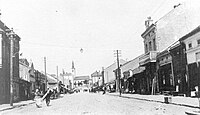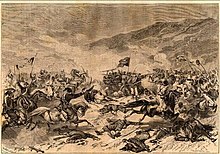Aleksinac
Aleksinac
Алексинац(Serbian) | |
|---|---|
Aleksinac town hall Church of St. Nicholas Town museum Ljupče Nikolić Elementary School Aleksinac Gymnasium Russian Monument Lake Bovan | |
| Coordinates:43°33′N21°42′E/ 43.550°N 21.700°E | |
| Country | |
| Region | Southern and Eastern Serbia |
| District | Nišava |
| Town status | 1516 |
| Municipality status | 1836 |
| Settlements | 72 |
| Government | |
| • Mayor | Dalibor Radičević(SNS) |
| Area | |
| • Town | 26.19 km2(10.11 sq mi) |
| • Municipality | 707 km2(273 sq mi) |
| Elevation | 168 m (551 ft) |
| Population (2022 census)[2] | |
| • Municipality | 43,258 |
| • Municipality density | 61/km2(160/sq mi) |
| Time zone | UTC+1(CET) |
| • Summer (DST) | UTC+2(CEST) |
| Postal code | 18220 |
| Area code | +381(0)18 |
| Car plates | AL |
| Website | www |
Aleksinac(Serbian Cyrillic:Алексинац) is a town and municipality located in theNišava Districtofsouthern Serbia.According to 2022 census, the municipality has a population of 43,258 inhabitants.
History
[edit]Prehistory and Antiquity
[edit]The territory of the municipality of Aleksinac has been inhabited since theneolithicage. Most of the settlements in the area belong to theVinčacultural group, and are located on the western side of theSouth Moravariver.
After the fall to theRomansthis territory was included in the province UpperMoesiaand after 293 AD it was in the Mediterranean provinceDacia.A Roman military road (Via Militaris) was built in 1st century AD across the territory. There were also two stations for rest (mansio) and change of horses (mutatio) along the road on the territory of Aleksinac: Praesidium Pompei and Rappiana.
Their location is still unknown, although there are few candidates for this position. Also few fortresses (Castell) are known to existed in this period, but their names are not known, except for the Castell Milareca on Gradiste hill (228 m).
Middle Ages
[edit]From the year 476 this territory was underByzantinerule. There are evidences of settlements from this time, however their names still remain unknown.
During the reigns of emperorsPhocas(602-610) andHeraclius(610-641) Slavic peoples inhabitBalkan peninsula.In 614 they razedNiš.The Via Militaris was renamed Medieval Military Road and it was used by the crusaders of first fourCrusadesto reachConstantinoplethus passing through the territory of Aleksinac municipality.
During the reign of theNemanjićdynasty this territory was under direct control of the state. After the death ofUroš Vthis territory was included in the territory ofMoravian Serbiaunder thePrince Lazarand his successors. Two medieval towns,BolvanandLipovac,date from this period.
Ottoman rule
[edit]
Aleksinac is first mentioned in 1516 in "Kruševački Tefter", a list of towns and its residents were made by Turks to keep an eye on taxes, as the village belonging to Bovan province andKruševacsanjak.It remained village up to the end of the 16th century when it was developed into town settlement.
In the middle of the 17th century, Aleksinac was town with more than 100 shops in it, and because of its strategic location on the road toIstanbulit became important travel and caravan station. Its importance can be supported by the fact that Turks builtfortressto protect it fromoutlawsin 1616.
The development of Aleksinac was stopped during the so-calledGreat Turkish War(1683–1699). Aleksinac was conquered by Austrian army (general Ludwig of Baden liberated it), and later burned to the ground by the soldiers of Jegen-Osman Pasha. Serbian inhabitants of Aleksinac joinedGreat Serb MigrationstoHabsburg monarchyand some of them settled down inBudim. Aleksinac was destroyed again by fire during thesecond Austro-Turkish war(1716–1718) whengrand vizierHallil Pasha was defeated beneath the walls ofBelgrade.In retreat he burned down all settlements all the way toNiš.
After thethird Austro-Turkish War(1737–1739) Aleksinac developed into significant trade and handcraft center. Manycaravanspassed through it exchanging wares from entireOttoman Empireandcentral Europe.At the same time it became center of Aleksinac county which in 1784 consisted of 17 villages. There were 160 houses in Aleksinac at that time, 120 of themChristianand 40Turkish.
After the fourthAustro-Turkish War(1787–1791) Aleksinac was burned down again by the Turkish outlaws led byOsman Pazvantoğlu.
Modern times
[edit]
Aleksinac and its surrounding area joined theFirst Serbian Uprisingin January 1806. This included villages on the right bank of theSouth Moravariver which were liberated by the army ofPetar Dobrnjac.
The settlements on the left bank were liberated byMladen MilovanovićandStanoje Glavaš.As soon as the town was liberated, CaptainVuča Žikićbuilt the famousDeligradtrenches on the north side of Aleksinac which earned fame in battles with the Turks, especially in 1806.
After the fall on the First Serbian Uprising, Aleksinac remained under Turkish rule up to December 1832 when it became integral part ofPrince Miloš'sSerbia. During his first reign Aleksinac became the economic centre of the south-east Serbia with numerous trade and handicrafts shops and it developed into important government centre.
It became a centre of county and county court. The thirdpost officein Serbia (after Belgrade andKragujevac) was opened in Aleksinac for both Serbian andAustrianpost as well as the place whereEnglishcourier sent and received the post fromTurkey.At that timeCustoms officeandquarantine stationwere built in Aleksinac.
Aleksinac was also the site of major battles withTurksin First Serbo-Turkish war in 1876, with only truevictory won on Šumatovac,3 kilometers from Aleksinac. From 1929 to 1941, Aleksinac was part of theMorava Banovinaof theKingdom of Yugoslavia.
Aleksinac was seriously damaged during theNATO bombing of Yugoslavia in 1999.
Settlements
[edit]Aside from the town of Aleksinac, the municipality includes the following settlements:
- Aleksinački Bujmir
- Aleksinački Rudnik
- Bankovac
- Beli Breg
- Belja
- Bobovište
- Bovan
- Bradarac
- Vakup
- Veliki Drenovac
- Vitkovac
- Vrelo
- Vrćenovica
- Vukanja
- Vukašinovac
- Glogovica
- Golešnica
- Gornja Peščanica
- Gornje Suhotno
- Gornji Adrovac
- Gornji Krupac
- Gornji Ljubeš
- Gredetin
- Grejač
- Dašnica
- Deligrad
- Dobrujevac
- Donja Peščanica
- Donje Suhotno
- Donji Adrovac
- Donji Krupac
- Donji Ljubeš
- Draževac
- Žitkovac
- Jakovlje
- Jasenje
- Kamenica
- Katun
- Koprivnica
- Korman
- Kraljevo
- Krušje
- Kulina
- Lipovac
- Loznac
- Loćika
- Lužane
- Ljupten
- Mali Drenovac
- Mozgovo
- Moravac
- Moravski Bujmir
- Nozrina
- Porodin
- Prekonozi
- Prćilovica
- Prugovac
- Radevce
- Rsovac
- Rutevac
- Srezovac
- Stanci
- Stublina
- Subotinac
- Tešica
- Trnjane
- Ćićina
- Crna Bara
- Česta
- Čukurovac
- Šurić
Demographics
[edit]| Year | Pop. | ±% p.a. |
|---|---|---|
| 1948 | 61,002 | — |
| 1953 | 64,344 | +1.07% |
| 1961 | 67,200 | +0.54% |
| 1971 | 66,082 | −0.17% |
| 1981 | 67,286 | +0.18% |
| 1991 | 63,844 | −0.52% |
| 2002 | 57,749 | −0.91% |
| 2011 | 51,863 | −1.19% |
| Source:[3] | ||
According to the last official census done in 2011, the municipality of Aleksinac has 51,863 inhabitants.[4]
Ethnic groups
[edit]The ethnic composition of the municipality:[4]
| Ethnic group | Population | % |
|---|---|---|
| Serbs | 47,563 | 91.71% |
| Roma | 1,937 | 3.73% |
| Macedonians | 98 | 0.19% |
| Montenegrins | 68 | 0.13% |
| Croats | 50 | 0.10% |
| Yugoslavs | 49 | 0.09% |
| Bulgarians | 45 | 0.09% |
| Muslims | 37 | 0.07% |
| Slovenians | 30 | 0.06% |
| Vlachs | 21 | 0.04% |
| Romanians | 20 | 0.04% |
| Albanians | 18 | 0.03% |
| Hungarians | 16 | 0.03% |
| Russians | 15 | 0.03% |
| Gorani | 13 | 0.03% |
| Others | 1,883 | 3.63% |
| Total | 51,863 |
Economy
[edit]The following table gives a preview of total number of registered people employed in legal entities per their core activity (as of 2018):[5]
| Activity | Total |
|---|---|
| Agriculture, forestry and fishing | 111 |
| Mining and quarrying | 327 |
| Manufacturing | 3,026 |
| Electricity, gas, steam and air conditioning supply | 30 |
| Water supply; sewerage, waste management and remediation activities | 274 |
| Construction | 205 |
| Wholesale and retail trade, repair of motor vehicles and motorcycles | 1,191 |
| Transportation and storage | 271 |
| Accommodation and food services | 289 |
| Information and communication | 62 |
| Financial and insurance activities | 82 |
| Real estate activities | 3 |
| Professional, scientific and technical activities | 214 |
| Administrative and support service activities | 71 |
| Public administration and defense; compulsory social security | 457 |
| Education | 838 |
| Human health and social work activities | 985 |
| Arts, entertainment and recreation | 86 |
| Other service activities | 139 |
| Individual agricultural workers | 819 |
| Total | 9,482 |
Tourism
[edit]Lake Bovan, situated 15 km from Aleksinac centre, is a place popular for tourists. The medieval monastery from the 15th century built by DespotStefan Lazarević,St. Stefan in Lipovac, is 25 km from the city. The monastery is built beneath the slopes of Mt. Ozren (1175 m). There is also remnants of two medieval towns in the mountains surrounding Aleksinac: Bovan and Lipovac, however they are not well preserved.
Notable people
[edit]- Kosta Taušanović(1854–1902), one of the founders ofSerbian Radical Party,minister of police and minister of commerce, founder of first insurance company in Serbia.
- Stevan Dimitrijević(1866–1953),theologian,historianandrectorof Theologian University inBelgrade.
- Mihailo Gavrilović(1868–1924) prominent Serbian historian and diplomat.
- Dragutin Jovanović-Lune(1892–1932), Serbian guerrilla fighter, officer, politician, delegate and mayor of Vrnjci. He was awarded several times for his service in the Balkan Wars and World War I.
- Dejan StojanovicSerbian musician, prominent guitar player.
- Jana RadosavljevićProfessional footballer. Born in Serbia, she plays for theNew Zealands women's national football team
Trivia
[edit]- The patron saint of Aleksinac isSt. Mark.
- Aleksinac was the first Serbian town to get a post office, on May 25, 1840. The second was opened inBelgradeand the third inKragujevac.
- Aleksinac is the home of the Native Indians Society of Serbia.
Twin towns – sister cities
[edit] Aiani,Greece
Aiani,Greece Hisarya,Bulgaria
Hisarya,Bulgaria Laurium,Greece
Laurium,Greece Probištip,North Macedonia
Probištip,North Macedonia Zagorje ob Savi,Slovenia
Zagorje ob Savi,Slovenia
References and further reading
[edit]- ^"Municipalities of Serbia, 2006".Statistical Office of Serbia.Retrieved2010-11-28.
- ^"Serbian census 2022"(PDF).Републички завод за статистику Србије.Републички завод за статистику.Retrieved30 December2023.
- ^"2011 Census of Population, Households and Dwellings in the Republic of Serbia"(PDF).stat.gov.rs.Statistical Office of the Republic of Serbia.Retrieved16 February2018.
- ^ab"ETHNICITY Data by municipalities and cities"(PDF).stat.gov.rs.Statistical Office of Serbia.Retrieved16 February2018.
- ^"MUNICIPALITIES AND REGIONS OF THE REPUBLIC OF SERBIA, 2019"(PDF).stat.gov.rs.Statistical Office of the Republic of Serbia.25 December 2019.Retrieved28 December2019.
- ^"Ministar Ružić i predstavnici iz Grčke, Slovenije, Bugarske, Makedonije i Rusije na proslavi Dana opštine Aleksinac".alpress.rs(in Serbian). AlPress. 2018-06-05.Retrieved2021-01-19.
- Istorija Aleksinca i okoline do kraja prve vladavine kneza Miloša,Sprić Miodrag, Aleksinac, 1995.
- Aleksinac i okolina,Dr. Branko Peruničić, Beograd, 1978.
















